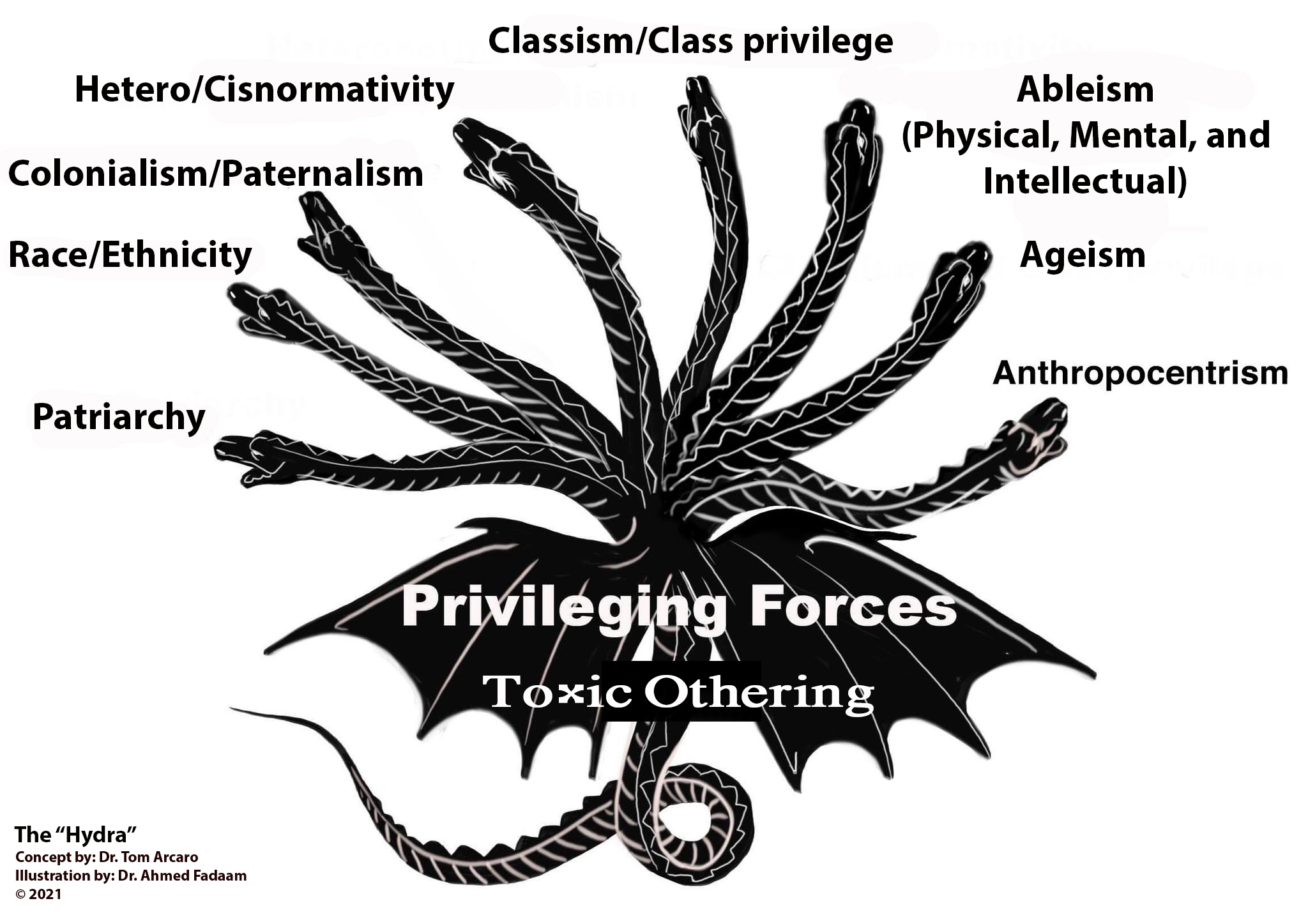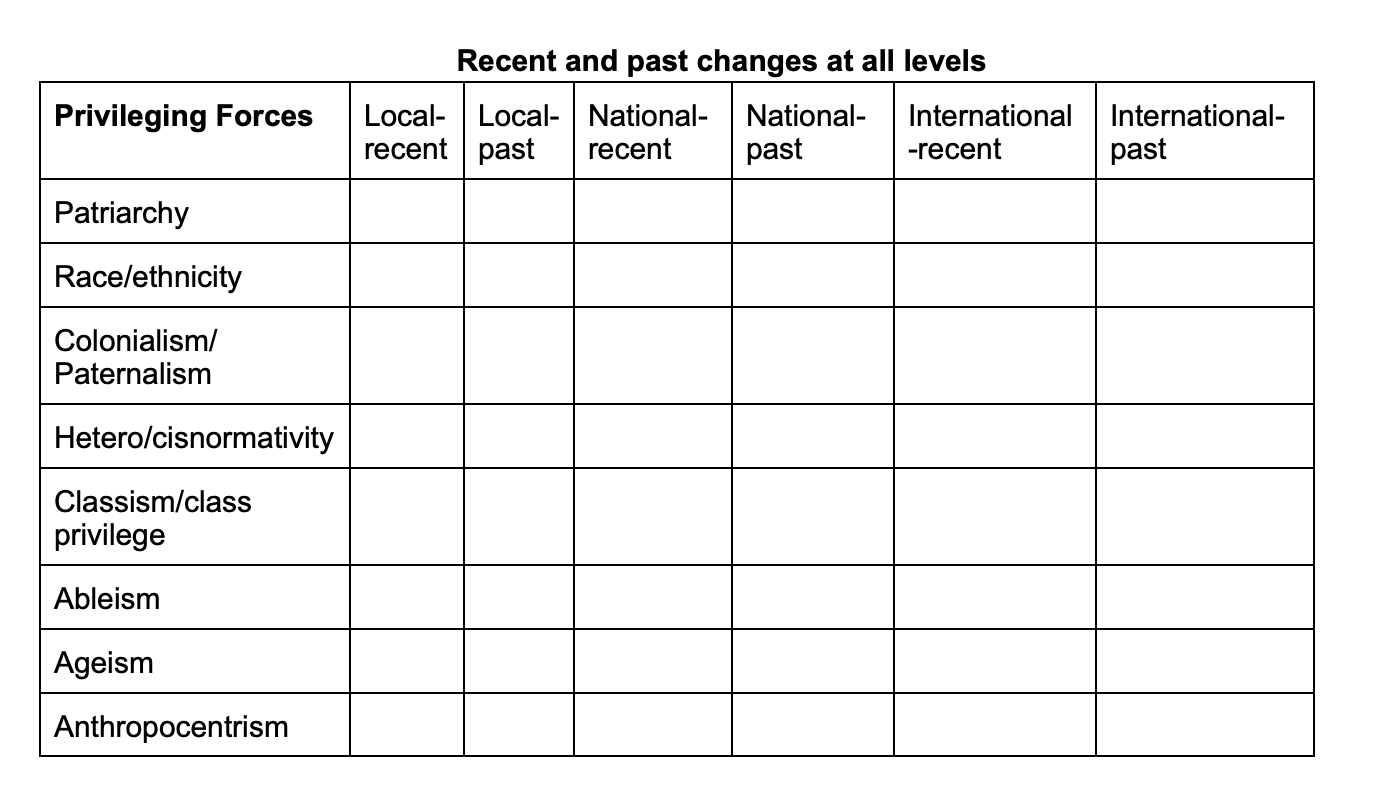Significantly updated 4-26-21
“My intent has been, is, and will continue to be, that those who read my works shall think and meditate upon fundamental problems, and has never been to hand them completed thoughts. I have always sought to agitate and, even better, to stimulate, rather than to instruct.
Neither do I sell bread, nor is it bread, but yeast or ferment.”
—Miguel de Unamuno
More thoughts on the Hydra: Hydra Theory 101
Preface
Humanitarians in all contexts need to be mindful of how privileging forces come in to play in virtually every interaction, person to person or organization to organization; within one’s organization or between the home organization and the affected populations. Awareness of cultural context is paramount, and understanding the Hydra is a useful tool. Standard training for any humanitarian includes defining and identifying examples of ethnocentrism. ‘Ethno’ means group and thus ethnocentrism is seeing everything from the value system and perspective of one’s own group or culture. Just as you will be hard pressed to be an effective humanitarian being ethnocentric, the same goes for being myopically centered in other ways. Think now of the heads of the Hydra.
Probing deeper with more questions
The Hydra analogy can be useful and discussions should always be grounded using practical examples that resonate on both the personal and organizational level. That said, I think there is a place for ‘Hydra Theory 101. Here are some additional thoughts and questions related to privileging forces, each a good point of departure for a deeper understanding. To be clear, all of the short explications I add to each is barely scratching the surface of what could be more deeply explored. [See here for all Hydra related posts.]
Racism the most significant privileging force?
Granted the basic fact of the complex and powerful intersectionality of all eight forces, each is unique. As they are depicted in the image of the Hydra, each head is the same size, inferring equivalent danger and harm. But can that be true? Certainly in this time of #BLM it be argued that racism and the xenophobia it gives rise to is far more powerful than most of the other privileging forces? But what about the other forces? Which is worse, sexism of racism, and by what measures? Can ableism be put next to classism in terms of harm?
What factors are involved?
Elsewhere I have argued that differentiation almost always deteriorates into stratification. Within the framework of sociocultural evolution it is not until recently, that is about 6000 years ago, that humans began to organize them selves into non-nomadic states. Prior to that we lived in much smaller groups mostly characterized by and egalitarian way of life. With the rise of agriculture and the domestication of animals and plant materials came this new form of social organization. It is in this context that all of the heads of the Hydra became much more virulent, and the transition from differentiation to stratification happened time after time. At the macro level a long view of world history indicates that many forms of differentiation resisted any such transition for tens of thousands of years, with perhaps hetero/cisnormatity and anthropocentrism being two examples. Anthropologists describe many cultures which functioned very well rejecting the concept of gender binary and which lived with an ethos that humans were are part of nature, and needed to respect other life on the planet.
On a more micro level, during face to face interaction for example, some differences in privileging statuses can remain benign for long periods only to degenerate into toxic othering. With rare exceptions, people have some privileged statues in most social interactions relative to the others present. Indeed, one can on both sides of the othering dynamic. The array and complexity of relative privileging statues increases exponentially as the number of participants increases. Every interaction has the possibility of being a microaggression1, intended or, more frequently, unintended. How does the flow of interactions become impacted by harmful comments (verbal or non-verbal)?
On both the macro and micro levels, under what  circumstances are these processes accelerated? Remain inhibited? Avoided all together?
circumstances are these processes accelerated? Remain inhibited? Avoided all together?
Which are easier to grasp?
Are some of the privileging forces more obvious to the typical observer and hence easier to grasp than others? Do most people even accept the premise of anthropocentrism?I think it is good to ask if the groups of individuals who are likely to be marginalized have their voices heard and under what conditions. Do most people even accept the premise of anthropocentrism, for example?
Religions normalizing and institutionalizing privileging?
Are some privileging forces more deeply woven into our major religions than others, for example sexism and heteronormativity? Certainly in their most fundamentalist forms all three Abrahamic religions appear to support racism, sexism, and heteronormativity at least as interpreted by the Taliban in Afghanistan and evangelicals in the US. Both seem quite certain that women and non-heteronormative people need to be treated as inferiors. That said, the Abrahamic religions originated based on ideologies of love and compassion. How is it that the baser emotions of hatred and fear and come to dominate the fringes in our modern cultures?
Unchecked capitalism and neoliberalism fuel the Hydra
And now we have to address the elephant in the room and ask the question, ‘Are some of the forces exasperated by and/or understood more easily relative to the forces of capitalism and neoliberalism than others?’ My cards on the table, I do believe that unchecked capitalism and neoliberalism have glorified and normalized gluttony and greed. We live in an absurd world where one person has more money than anyone could use in hundreds of lifetimes. Neoliberalism is in ideology based on the assumption that a free market is efficient in proportion to levels of government regulation: less control, more freedom and efficiency. A free market, unhindered by governments or governmental regulation, will be able to organically identify and then find ways to monetize the satisfaction of all human needs. Capitalism is the economic system which drives the neoliberal agenda. Neoliberalism may indeed be the idea that swallowed the world.
I have written in some detail that all of the heads of the Hydra have in common the act  of ‘othering’, and that social differentiation -any differences humans may have- almost inevitably degenerates into stratification where one group justifies dominating the other. All of the ‘isms’ represented by the Hydra are made possible by othering and the subsequent justification of the domination of one group by another.
of ‘othering’, and that social differentiation -any differences humans may have- almost inevitably degenerates into stratification where one group justifies dominating the other. All of the ‘isms’ represented by the Hydra are made possible by othering and the subsequent justification of the domination of one group by another.
If othering is the heart of the Hydra then perhaps capitalism and neoliberalism are the food, the fuel.
Let’s go through each of the eight heads of the Hydra and imagine how capitalism and neoliberalism make them more toxic, more dangerous.
- Patriarchy: Does capitalism support the patriarchy? Can feminism and capitalism coexist? How do patriarchy and capitalism jointly reinforce the oppression of women? These are just a few of the many questions that must be asked, and there are scores of scholars, past and present, doing just that, most answering with a strong affirmation that capitalism contributes to sexism.
- Racism: Some argue that racism and capitalism are conjoined twins. The North Atlantic slave trade is just one example; there are countless others. This is worth extensive discussion and is indeed the premise of countless books and articles.
- Colonialism/Paternalism: A recent article in The Guardian “The Invention of Whiteness: the long history of a dangerous idea” does a very good job sketching out how ‘whiteness’ was invented and then used to justify racism and its place in the rise of the colonial powers. William Easterly’s The Tyranny of Experts (see chapter 4) is an earlier description of same. The research on this topic is copious, compelling, and a must read for anyone wanted to ‘decolonize’ the humanitarian sector.
- Hetero/cisnormativity: The argument that Queer Oppression is Etched in the Heart of Capitalism is not uncontroversial, and there is a rich (albeit somewhat recent) range of discussion on this topic.
- Classism/class privilege: Well, this one speaks for itself. Charles Darwin and Karl Marx had much in common but nothing more significant than the fact that they both articulated fundamental algorithms. Biologist Theodosius Dobzhansky argued that “Nothing in Biology Makes Sense Except in the Light of Evolution.” In that same vein and following the lead of the economic determinism articulated by Marx, I will argue that nothing in society makes sense except in the light of capitalism. This of course includes all of the damage done by the glorification and normalization of gluttony and greed.
- Ableism (physical, mental, and intellectual): As I write this there are waves of critique aimed at the United States for hoarding of vaccines. Disasters -in this case a global pandemic- always hit those on the margins the hardest, especially physical or health related events. That Covid has been horrific for those who are disabled is not in question. Capitalism is based on a myopic quest to maximize profits, and hence have both an economic and ideological interest to exclude workers based on perceived disability.
- Ageism: Linked to ableism, ageism is woven into the very fabric of modern capitalism where workforces value youth. Capitalism profits from making us fear aging.
- Anthropocentrism: We are on the brink of environmental collapse. The climate crisis is real and is causing increasingly frequent extreme weather events which generate the need for a humanitarian response. The recent Zoom meeting of global leaders is likely to yield more talk than action largely because the mantra of capitalism is to protect jobs at any cost. Our mentality of exploitation is driven by our quest for ‘freedom’ from oppressive government interference, the very core philosophy of liberalism. Destruction of the planet will proceed apace if there’s a buck to be made. Convince me otherwise.
Each of the above discussions is worth having in more detail, of course, but I think my point has been made: the heads of the Hydra are all fueled by capitalism and neoliberal ideas.
Additional questions to consider:
- With respect to intersectionality, are some forces more salient than others, i.e., have more multiplicative properties?
- Are some of these forces more culturally universal than others? Indeed, as our world becomes more globalized and homogenized by transnational trade, communication, and media consumption I will argue that toxic privileging forces exist in varying degrees in all world cultures.
- People can have privileged statuses, of course, but so can organizations. Does an INGO based in the Global North have more sway in, for example, a cluster meeting?
- By taming these individual heads I mean ‘bending the moral arc’ by changing behavioral norms, instituting policies, passing and enforcing local, national, and international laws, and other proactive measures. Which heads are easiest to tame and which are the hardest? Related, do (for example) passing laws related to one head make change relative to the other heads easier? Doing anti-sexism laws impact laws related to racism or vice versa, for example?
Hydra Theory 101
I started this post with a quote from my favorite philosopher, Miguel de Unamuno. He said, “Neither do I sell bread, nor is it bread, but yeast or ferment.” And that is exactly what I am offering here, an invitation to press to its edges this Hydra metaphor. From these abstract ideas and challenges I suggest we now turn to something more straightforward.
A group exercise using the Hydra
Below is a group exercise which may help individuals deepen understanding of the Hydra’s privileging forces. This exercise can be used with everyone from young undergraduates to seasoned humanitarians. A facilitator will need to frame the exercise and act as a guide through the questions and subsequent discussion, taking notes as examples are given and points are made.
Noting your privilege: an exercise
Though not a high percentage of our overall population, globally there are many people who would be on the marginalized side of all seven (now eight counting anthropocentrism) heads of the Hydra. One can imagine a for example, an elderly, poor, blind, non-white, lesbian from the majority world (aka Global South). That point granted, the vast majority of people across the world ‘enjoy’ one or more privileged statues.
For this exercise identity all of your privileges. One by one describe a situation where you gained some benefit or advantage from each. Now consider the following questions:
- Assuming you enjoy more than one privileged status, are there situations where you were not sure which
privilege have gave you an advantage in a particular situation? - Were there situations when you realized in the moment that you were enjoying this privilege?
Were there situations when you realized only later after reflection that you had enjoyed this privilege?
- Do you think others in the situation who shared your privilege were aware of the fact that you were gaining advantage based on your privilege? How do you think they felt?
- Do you think others in the situation who did not share your privilege were aware of the fact that you were gaining advantage based on your privilege? How do you think they felt?
- In each situation, how did you feel about gaining advantages based on your privilege?
- As you move through your day how common is it for you to go from a situation where you have privilege to one where you are marginalized?
- To what degree were you aware that you could use your position of privilege to be an ally to others? What does it mean to be an ally?
- Describe a situation where you simultaneously were both privileged and marginalized.
- What norm changes, new or revised policies laws, and/or additional enforcement of any existing or new policies and laws can you suggest that might defuse awkward, unfair, and/or marginalizing privileging asymmetries?
The facilitator can bring the discussion to a close by listing all of the major points made, highlighting particularly useful and relevant examples, and by underscoring the need to examine useful, practical and effective ways to encourage interactional patterns which minimizes the impact of these privileging forces and maximizes the chance for structural changes which mitigate the perpetuation of the negative impacts of these forces.
Identifying examples of taming the Hydra
Looking at this grid, participants are asked to contribute examples of actions which have helped ‘tame the Hydra’ and bend the moral arc toward justice. Examples can be from history or recent activities, and the overall goal of this exercise is to create a database of examples which may inspire others to act.
Here are some examples, mostly from the US.
Patriarchy: At the national leveling the US, Title IX states that “No person in the United States shall, on the basis of sex, be excluded from participation in, be denied the benefits of, or be subjected to discrimination under any education program or activity receiving Federal financial assistance.” This law had the intended impact, not fully realized at yet of literally ‘evening the playing field’ for female athletes in the US.
Race/ethnicity
1Microaggressions in Everyday Life (2nd edition 2020) by Derald Wing Sue and Lisa Spanierman explore microaggressions in the context of higher education in the US. Their insights are easily transferred to other settings and I think this book might be useful for those in the humanitarian sector.



 Follow
Follow